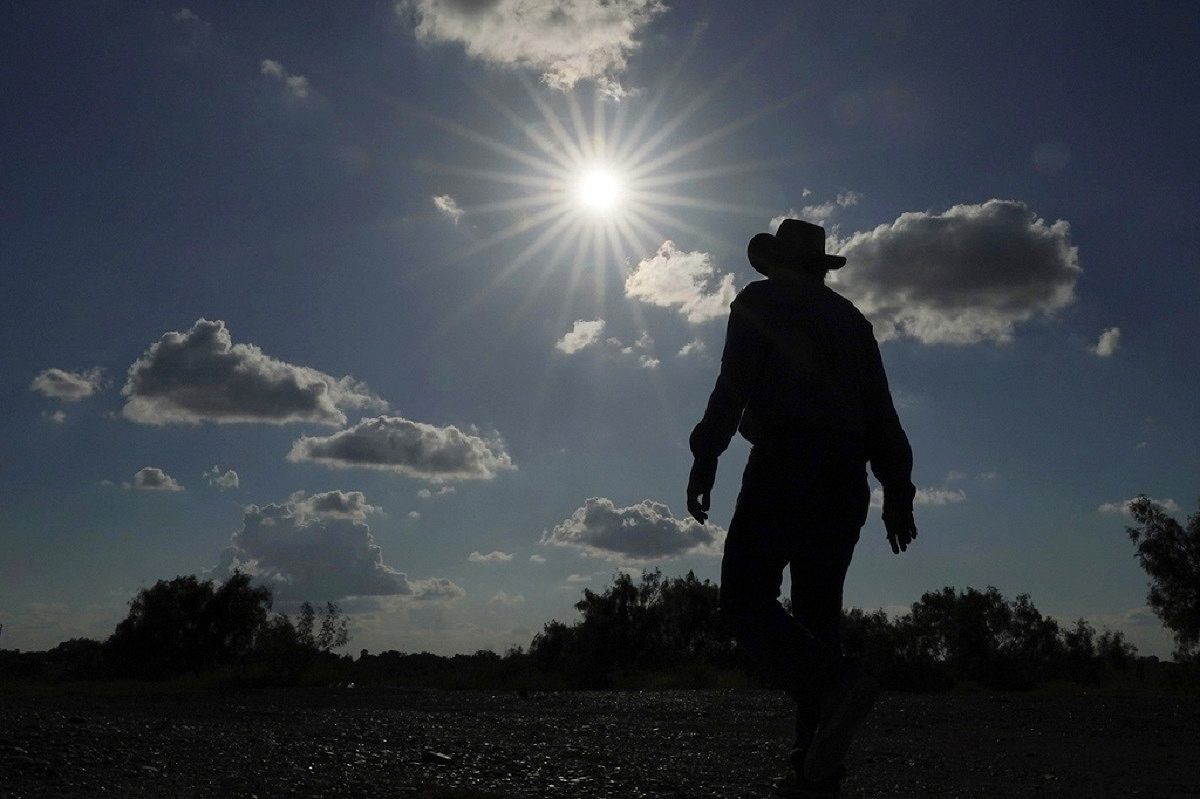AP Analysis Finds 2023 Set Record for US Heat Deaths, Killing in Areas that used to Handle the Heat

Jessie Fuentes, who works providing people with canoes and kayaks, walks along the Rio Grande with the sun pushing the temperature into the 90s on July 6, 2023.
11:35 JST, June 1, 2024
David Hom suffered from diabetes and felt nauseated before he went out to hang his laundry in 108-degree weather, another day in Arizona’s record-smashing, unrelenting July heat wave.
His family found the 73-year-old lying on the ground, his lower body burned. Hom died at the hospital, his core body temperature at 107 degrees.
The death certificates of more than 2,300 people who died in the United States last summer mention the effects of excessive heat, the highest number in 45 years of records, according to an Associated Press analysis of Centers for Disease Control and Prevention data. With May already breaking heat records, 2024 could be even deadlier.
And more than two dozen doctors, public health experts, and meteorologists told the AP that last year’s figure was only a fraction of the real death toll. Coroner, hospital, ambulance and weather records show America’s heat and health problem at an entirely new level.
“We can be confident saying that 2023 was the worst year we’ve had from since … we’ve started having reliable reporting on that,” said Dr. John Balbus, director of the Office of Climate Change and Health Equity at the Department of Health and Human Services.
Last year, ambulances were dispatched tens of thousands of times after people dropped from the heat. It was relentless and didn’t give people a break, especially at night. The heat of 2023 kept coming, and people kept dying.
“It’s people that live the hot life. These are the ones who are dying. People who work outside, people that can’t air-condition their house,” said Texas A&M climate scientist Andrew Dessler, who was in hard-hit southern Texas. “It’s really quite, quite grim.”
Dallas postal worker Eugene Gates Jr., loved working outdoors and at 7:30 a.m. June 20, the 66-year-old texted his wife that it was close to 90 degrees. He kept working in the heat that felt like 119 degrees with the humidity factored in and finally passed out in somebody’s yard. He ran a fever of 104.6 degrees and died, with the medical examiner saying heat contributed to his death.
“The way that my husband died, it could have been prevented,” said Carla Gates.
“There’s just very low awareness that heat kills. It’s the silent killer,” said University of Washington public health scientist Kristie Ebi, who helped write a United Nations special report on extreme weather. That 2012 report warned of future dangerous heat waves.
Ebi said in the last few years, the heat “seems like it’s coming faster. It seems like it’s more severe than we expected.”
DEATHS DOWN SOUTH
Last summer’s heat wave killed differently than past ones that triggered mass deaths in northern cities where people weren’t used to the high temperatures and air conditioning wasn’t common. Several hundreds died in the Pacific Northwest in 2021, in Philadelphia in 1998 and in Chicago in 1995.
Nearly three-quarters of the heat deaths last summer were in five southern states that were supposed to be used to the heat and planned for it. Except this time they couldn’t handle it, and it killed 874 people in Arizona, 450 in Texas, 226 in Nevada, 84 in Florida and 83 in Louisiana.
Those five states accounted for 61% of the nation’s heat deaths in the last five years, skyrocketing past their 18% share of U.S. deaths from 1979 to 1999.
At least 645 people were killed by the heat in Maricopa County, Arizona, alone, according to the medical examiner’s office. People were dying in their cars and especially on the streets, where homelessness, drug abuse and mental illness made matters worse.
Three months after being evicted from her home, 64-year-old Diana Smith was found dead in the back of her car. Her cause of death was methamphetamine and fentanyl, worsened by heat exposure, Phoenix’s medical examiner ruled.
“In the last five years, we are seeing this consistent and record kind of unprecedented upward trend. And I think it’s because the levels of heat that we have seen in the last several years have exceeded what we had seen in the last 20 or 30,” said Balbus, of the Office of Climate Change and Health Equity at the Department of Health and Human Services.
UNRELENTING HEAT
Phoenix saw 20 consecutive days of extreme heat stress in July, the longest run of such dangerously hot days in the city since at least 1940, according to the data from the Copernicus Climate Change Service.
Phoenix wasn’t alone.
Last year the U.S. had the most heat waves since 1936. In the South and Southwest, Last year was the worst on record, according to the National Oceanic and Atmospheric Administration.
“It was crazy,” said University of Miami tropical meteorology researcher Brian McNoldy, who spent the summer documenting how Miami broke its daily heat index record 40% of the days between mid-June and mid-October.
Houston’s Hobby airport broke daily high temperature marks 43 times, meteorologists said. Nighttime lows set records for heat 57 times, they said. That didn’t give people’s bodies chances to recover.
Across five southern states, the average rate of emergency department visits for heat illness in the summer of 2023 was over double that of the previous five summers, according to an analysis of data from the CDC.
THE DEATHS
Experts warned that counting heat mortality based on death certificates leads to underestimates. Heat illness can be missed, or might not be mentioned.
They pointed to “excess death” studies for a more realistic count. These are the type of long-accepted epidemiological studies that look at grand totals of deaths during unusual conditions — such as hot days, high air pollution or a spreading COVID-19 pandemic — and compare them to normal times, creating an expected trend line.
Texas A&M’s Dessler and his colleague Jangho Lee published one such study early last year. According to their methods, Lee said, about 11,000 heat deaths likely occurred in 2023 in the U.S. — a figure that would represent a record since at least 1987 and is about five times the number reported on death certificates.
Deaths are also up because of better reporting, and because Americans are getting older and more vulnerable to heat, Lee said. The population is also slowly shifting to cities, which are more exposed to heat.
THE FUTURE
In some places, last year’s heat already rivals the worst on record. As of late May, Miami was on track to be 1.5 degrees warmer than the hottest May on record, according to McNoldy. Dallas’ Murphy pointed to maps saying conditions with a broiling Mexico are “eerily similar to what we saw last June” so he is worried about “a very brutal summer.”
Texas A&M’s Dessler said last year’s heat was “a taste of the future.”
“I just think in 20 years, you know, 2040 rolls around … we’re going to look back at 2023 and say, man, that was cool,” Dessler said. “The problem with climate change is if if it hasn’t pushed you over the edge yet, just wait.”
"News Services" POPULAR ARTICLE
-

American Playwright Jeremy O. Harris Arrested in Japan on Alleged Drug Smuggling
-

Japan’s Nikkei Stock Average as JGB Yields, Yen Rise on Rate-Hike Bets
-

Japan’s Nikkei Stock Average Licks Wounds after Selloff Sparked by BOJ Hike Bets (UPDATE 1)
-

Japan’s Nikkei Stock Average Buoyed by Stable Yen; SoftBank’s Slide Caps Gains (UPDATE 1)
-

Japanese Bond Yields Zoom, Stocks Slide as Rate Hike Looms
JN ACCESS RANKING
-

Keidanren Chairman Yoshinobu Tsutsui Visits Kashiwazaki-Kariwa Nuclear Power Plant; Inspects New Emergency Safety System
-

Tokyo Economic Security Forum to Hold Inaugural Meeting Amid Tense Global Environment
-

Imports of Rare Earths from China Facing Delays, May Be Caused by Deterioration of Japan-China Relations
-

University of Tokyo Professor Discusses Japanese Economic Security in Interview Ahead of Forum
-

Japan Pulls out of Vietnam Nuclear Project, Complicating Hanoi’s Power Plans
























